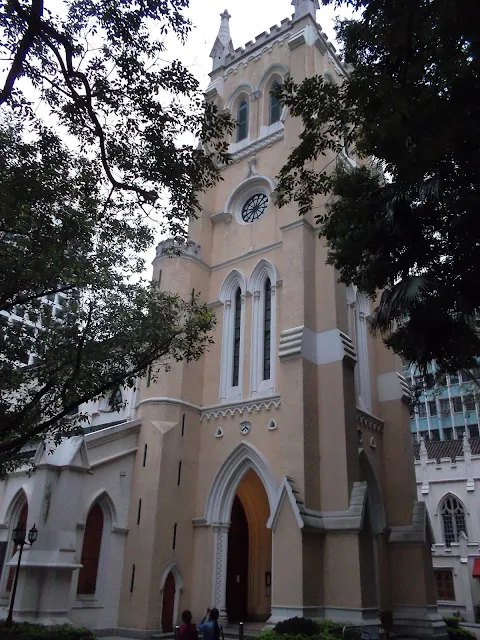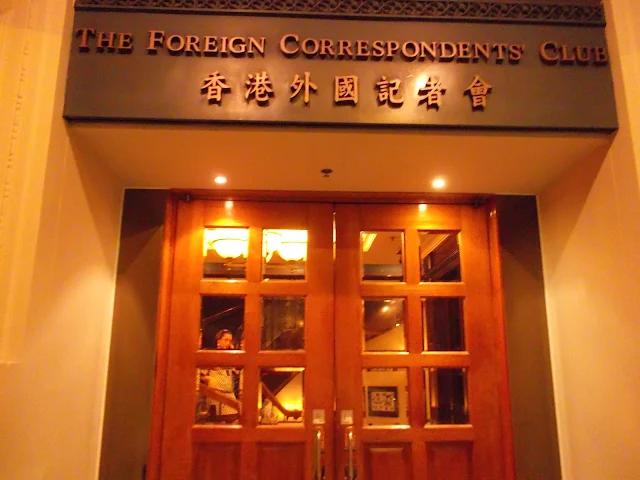From Chater Garden it is easy to reach Queen's Road, which is connected to Battery Path via a stone staircase.
When you get to Battery Path you will see on the left the red-brick building of the former French mission (below), which is now the seat of the Court of Final Appeal. It was originally built in 1868 for the Russian Consul in Hong Kong. Later it was used by the American trading company Heard and Co., which subsequently went bankrupt (Wordie 2002, p. 22). In 1915 it was bought by the French Mission Etrangere which renovated it and added a chapel and a dome (Vines 2002, pp. 38-39).
When you get to Battery Path you will see on the left the red-brick building of the former French mission (below), which is now the seat of the Court of Final Appeal. It was originally built in 1868 for the Russian Consul in Hong Kong. Later it was used by the American trading company Heard and Co., which subsequently went bankrupt (Wordie 2002, p. 22). In 1915 it was bought by the French Mission Etrangere which renovated it and added a chapel and a dome (Vines 2002, pp. 38-39).
 |
| The Court of Final Appeal. Apparently this is a nice spot where to take wedding pictures |
 |
| The Court of Final Appeal as seen from Chater Garden |
 |
| Facade of the Court of Final Appeal opposite St John's Cathedral |
Opposite the Court of Final Appeal is St John's Cathedral, completed in 1850. It was built in an area that was frequented mostly by the expatriate community, close to Government House, the Peak Tram and several administrative buildings (Vines 2002, pp. 40-41). The Europeans tended to settle in the hill areas of Hong Kong, where they could to escape the heat and humidity of the city... and the native population. Since 1849 St John's Cathedral has been the seat of the Anglican Diocese of Hong Kong (ibid.).
 |
| St John's Cathedral. Again, the trees make it impossible to take a decent picture of it... |
 |
 |
| St John's Cathedal Bookstore, right next to the cathedral itself |
Descending Queen's Road you will reach Garden Road which leads to the Peak Tram and the American Consulate.
 |
| The Peak Tram |
Garden Road is connected through a staircase to Upper Albert Road, from where one can easily reach Government House, the former residence of the British governors and, after the handover to China in 1997, home to the Chief Executive of the Hong Kong SAR.
In the first years of the British colony, the governors appointed by London didn't have a proper residence, but lived in rented houses (Lung 1999, p. 38). Government House was built in 1851 and enjoyed a commanding view of the harbour, which was later blocked by the huge building erected all around it.
By the 1930s the building had been damaged by typhoons and was infested with beetles and borers. When the Japanese occupied Hong Kong in 1941, they demolished it and rebuilt it in their own way, that is, in a Western-style architecture with Japanese elements, the most remarkable of which is a Japanese-style tower. When the British resumed the administration of Hong Kong in 1945, they removed the tatamis and other Japanese furniture and decorations from the interior, but left the exterior unchanged so that, ironically, the centre and symbol of the British colonial government in Hong Kong was actually a remainder of the short-lived Japanese rule (Wordie 2002, p. 65 / Bailey 2009, p. 29).
Unfortunately, Government House is guarded by police officers and it is not possible to go beyond the main gate.
 |
| Government House with the Japanese-style tower on the right side |
Descending Upper and Lower Albert Road you will get to Bishop's House, which was built in 1851 to be the residence of Hong Kong's first bishop. The building is believed to be the oldest residence in the city (Vines 2002, pp. 44-45).
 |
| Bishop's House |
Further down in Ice House Street is the Foreign Correspondent's Club (formerly Dairy Farm Building). The building was used by the Dairy Farm Ice and Cold Storage Co. Ltd. from 1892 onward. It was renovated in 1913. The complex now houses the exclusive Fringe Club and the Foreign Correspondents' Club. The Fringe Club is an arts and exhibition centre which prides itself on being a medium of free expression. In fact, artists can use the rooms of the club without having to go through a selection process. The Fringe Club was opened in 1984 and has ever since been an important hub of Hong Kong's arts' scene (note). The most prestigious event organized in the Fringe Club is the renowned Man Asian Literary Prize (Wordie 2007, p. 45).
The Foreign Correspondents' Club (FCC) is the meeting point for journalists from all around the world. The history of the FCC began in 1943 in Republican China, which was at that time in the grip of a deadly struggle against Japanese invaders. Chiang Kai-shek, the leader of the Guomindang, which was the party ruling the Republic of China, decided after a series of defeats inflicted to his troops by the Japanese to retreat to the city of Chongqing. Chongqing, now famous for its double-digit growth rates and for Bo Xilai, was back then a backward, sleepy and poor town. However, it had an advantageous strategic position. Chiang Kai-shek and his entire government personnel made Chongqing the temporary capital of the Republic of China. The retreating Guomindang forces were followed by teams of foreign correspondents. In 1943 they founded the FCC. After the end of the war, the club moved to Nanjing. Then the civil war between the Guomindang and the Communists broke out. The FCC first fled to Shanghai, and when it became clear that the Communists would win, it relocated to Hong Kong. From the British enclave foreign journalists had a free basis from where they could report on major events such as the Korean War and the Vietnam War. After moving its headquarters several times, in 1982 the FCC was granted a lease on its present location (note; Ingham 2007, pp. 44-45/ White 1980).
 Moving down Ice House Street one can see two original gas lamps from the Victorian era. If there were not a plaque informing that they are listed as public monuments, one would probably not even notice them. At the end of Ice House is Pedder Street, named after William Pedder, the Harbour Master in 1841 (Yanne / Heller 2009, p. 91). Not much is left from the old street except for an old office building known as Pedder Building, which was constructed in 1923. One of the upper floors of the Pedder Building houses the China Tea Club, which fortunately is not as exclusive as most other Hong Kong Clubs.
Moving down Ice House Street one can see two original gas lamps from the Victorian era. If there were not a plaque informing that they are listed as public monuments, one would probably not even notice them. At the end of Ice House is Pedder Street, named after William Pedder, the Harbour Master in 1841 (Yanne / Heller 2009, p. 91). Not much is left from the old street except for an old office building known as Pedder Building, which was constructed in 1923. One of the upper floors of the Pedder Building houses the China Tea Club, which fortunately is not as exclusive as most other Hong Kong Clubs.  |
Sources:
The market leader for reservations to the Budget, Independent and Youth Travel market; providing online confirmed bookings for over 25,000 properties worldwide.Check your Hostel and BBs now.








Comments
Post a Comment